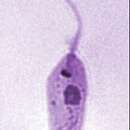en
names in breadcrumbs


Crithidia is a genus of trypanosomatid Euglenozoa. They are parasites that exclusively parasitise arthropods, mainly insects. They pass from host to host as cysts in infective faeces and typically, the parasites develop in the digestive tracts of insects and interact with the intestinal epithelium using their flagellum. They display very low host-specificity and a single parasite can infect a large range of invertebrate hosts.[3] At different points in its life-cycle, it passes through amastigote, promastigote, and epimastigote phases; the last is particularly characteristic, and similar stages in other trypanosomes are often called crithidial.
The etymology of the genus name Crithidia derives from the Ancient Greek word κριθίδιον (krithídion), meaning "small grain of barley".[4][5]
These parasites may be at least partially responsible for declining wild bumble bee populations. They cause the bumble bees to lose their ability to distinguish between flowers that contain nectar and those that don't. They make many mistakes by visiting nectar scarce flowers and in so doing, slowly starve to death. Commercially bred bumble bees are used in greenhouses to pollinate plants, for example tomatoes, and these bumble bees typically harbor the parasite, while wild bumble bees do not. It is believed that the commercial bumble bees transmitted the parasite to wild populations in some cases. They escape from the greenhouses through vents; a simple mesh could help prevent this.[11]
E Riddell, Carolyn; D Lobaton Garces, Juan; Adams, Sally (27 November 2014). "Differential gene expression and alternative splicing in insect immune specificity". BMC Genomics. 15 (1): 1031. doi:10.1186/1471-2164-15-1031. PMC 4302123. PMID 25431190. ![]()
Otterstatter, Michael C.; Thomson, James D. (23 July 2008). "Does Pathogen Spillover from Commercially Reared Bumble Bees Threaten Wild Pollinators?". PLOS ONE. 3 (7): e2771. Bibcode:2008PLoSO...3.2771O. doi:10.1371/journal.pone.0002771. PMC 2464710. PMID 18648661. ![]()
Daniel, Cariveau; Elijah, Powell; Hauke, Koch (April 2014). "Variation in gut microbial communities and its association with pathogen infection in wild bumble bees (Bombus)". The ISME Journal. 8 (12): 2369–2379. doi:10.1038/ismej.2014.68. PMC 4260702. PMID 24763369.
Crithidia is a genus of trypanosomatid Euglenozoa. They are parasites that exclusively parasitise arthropods, mainly insects. They pass from host to host as cysts in infective faeces and typically, the parasites develop in the digestive tracts of insects and interact with the intestinal epithelium using their flagellum. They display very low host-specificity and a single parasite can infect a large range of invertebrate hosts. At different points in its life-cycle, it passes through amastigote, promastigote, and epimastigote phases; the last is particularly characteristic, and similar stages in other trypanosomes are often called crithidial.
The etymology of the genus name Crithidia derives from the Ancient Greek word κριθίδιον (krithídion), meaning "small grain of barley".